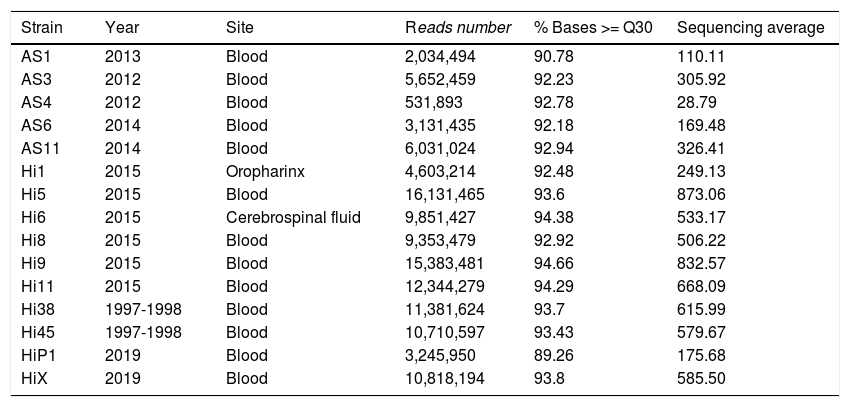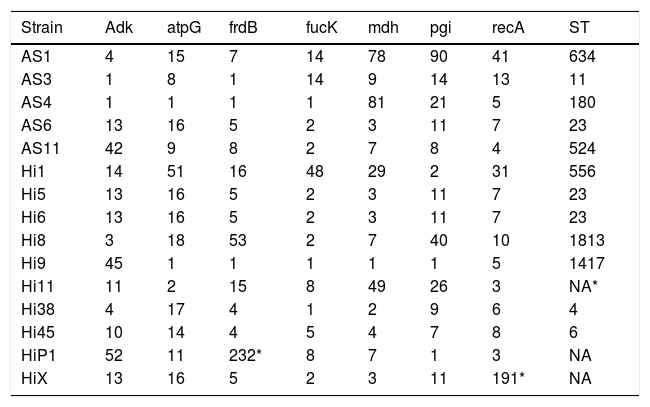Thirteen Haemophylus influenzae invasive strains isolated from patients at Clinical Hospital of State University of Campinas, from May 2013 through August 2019, was submitted to Illumina genome sequencing HiSeq platform. Further in silico analysis of serogroup and Multi Locus Sequence Typing (MLST) from whole DNA sequencing had demonstrated the actual clonal distribution in the Campinas Metropolitan region. Thus, results showed the existence of a new ST Haemophilus influenzae found in the Brazilian territory and an increase of strains belonging to serogroup a (three strains also belonging to ST23). In conclusion, we observed an increase of non-typable H. influenzae (NTHi) and a strain involved in invasive diseases in the Campinas – São Paulo region after frequent detection of those serotypes and genotypes in other Brazilian regions.
Haemophilus influenzae is an important pathogen involved in several invasive diseases that might progress to meningitis, septicemia and death. Also, Haemophilus influenzae is known as pleomorfic Gram negative cocobacilus classified in six immunological encapsulated strains (a-f) and non-typable H. influenzae – NTHi. The H. influenzae type b (Hib) is the most invasive type commonly associated with meningitis and other upper respiratory tract infections in children and adults.1,2 The NTHi strains are associated with moderate diseases of the upper respiratory tract and otitis media in children and pneumonia in adults with cystic fibrosis.3,4 Along with the introduction of Hib conjugate vaccine, epidemiology of H. influenzae has changed in recent years. NTHi and other serotypes of H. influenzae has become more prevalent than Hib around the world. Outbreaks at the Clinical Hospital of University of Campinas, São Paulo State – Brazil have shown an increase of invasive strains after vaccination. The use of Illumina platform for bacterial whole-genome construction set up by our group for characterization of Brazilian Pupuric fever Haemophilus strains (Pereira et al. 20195) was used for this purpose. This work aimed to use the Illumina sequencing method for draft-genome to characterize genome structure and in silico virulence factors of 13 invasive strains isolated from blood and cerebrospinal fluid. In addition, an approach about the virulence mechanisms and vaccine escape will be explored in this work.
Material and methodsBacterial strainsThirteen H. influenzae strains were isolated between May 2013 and August 2019 from patients in the Clinical Hospital of State University of Campinas (HC-UNICAMP). All strains were isolated from blood cultures except one Hi2015-6 isolated from cerebrospinal fluid. Hi38 and Hi45 strains had been characterized by Lancellotti et al. 20086 and also isolates from the same hospital in 1998. The bacterial strains were grown in chocolate agar plates or BHI supplement with NAD (4 µg/ mL) and hemin (10 µg/ mL) (Kilian, 19767) and incubated at 37°C with 5% CO2.6
Whole-genome sequencing, assembly, and annotationGenomic DNA was extracted as described and adapted by Cury et al. 2014.8 The DNA quality analysis and quantification were performed with NanoDrop (NanoDrop® 2000 - Thermo Scientific®). Libraries were prepared with the Nextera XT DNA library preparation kit (Illumina, CA, USA) and sequenced using the Illumina HiSeq 2500 platform (100-bp single-end reads) at the Genomics section of the Life Sciences Core Facility (LaCTAD, Campinas, São Paulo, Brazil). All libraries were multiplexed on one sequencing run. Quality of reads files were evaluated with FastQC v.0.11.7 (Babraham Bioinformatics, Cambridge, UK). Sequencing reads were trimmed, assembled, and annotated in through PATRIC pipeline v.3.5.43 (https://patricbrc.org/).9 Reads were trimmed by quality (Quality Phred score > 20) and size (> 20 pb) and Illumina adapters sequences were removed using the FastqUtils tool with Trim Galore v. 0.6.1 and Cutadapt v. 2.2. Assembly and annotation were performed using the tool Genome Comprehensive Analysis with SPAdes v. 3.10.010 with default parameters and RAST tool kit (RASTtk),11 respectively.
Capsular operon analysis and MLST determinationCapsular genes were identified using a BLASTn search with Hicap software12,13 and Geneious Prime® 2020.1.1 (https://www.geneious.com). For the Multi Locus Sequence Typing (MLST) determination, genes sequences for the housekeeping genes adk, atpG, adk, atpG, frdB, fucK, mdh, pgi, and recA were analyzed at Haemophilus influenzae MLST website (https://pubmlst.org/hinfluenzae/) sited at the University of Oxford14 for allele and sequence type (ST) assignment.
Virulence genes and antimicrobial resistance genotypesVirulence factors and acquired resistance genes were assessed using the Virulence Factors Database (VFDB)15 and ResFinder v. 2.1,16 respectively.
ResultsThe sequencing of strains using the HiSeq2500 platform generated a total of 214,376,882 reads for a total of 19 samples. Table 1 summarizes the raw data from the sequencing of 14 samples analyzed. It is observed that the number of reads generated per sample ranged from 16,131,465 to 45,305 (Hi5 and Hi4 samples respectively), with an average percentage above 90% of bases with a phred score = 20. All analyzes performed are attached to this report with all contigs and genomic notations.
Data of sequencing of H. influenzae strains.
Still analyzing the properties and data of the sequenced genomes, the MLST (Table 2) analyses were performed in order to obtain a clonal analysis of the strains isolated in this study. Furthermore, strains isolated between 1997-1998 called ancestor strain (Hi38), strains isolated already in the years 2010, and strains isolated in 2019 (AS's and Hi's) were analyzed with a draft-whole genome. Regarding the MLST analysis of all strains, new alleles were found in our strains isolated in 2019 (frdB allele 232 and recA allele 191 of HiP1 and HiX, respectively). In addition, new sequences type for H. influenzae found in the Hi11, HiP1 and HiX strains (curated on the MLST website) were also determined.
MLST genes and sequencing type of H. influenzae strains.
| Strain | Adk | atpG | frdB | fucK | mdh | pgi | recA | ST |
|---|---|---|---|---|---|---|---|---|
| AS1 | 4 | 15 | 7 | 14 | 78 | 90 | 41 | 634 |
| AS3 | 1 | 8 | 1 | 14 | 9 | 14 | 13 | 11 |
| AS4 | 1 | 1 | 1 | 1 | 81 | 21 | 5 | 180 |
| AS6 | 13 | 16 | 5 | 2 | 3 | 11 | 7 | 23 |
| AS11 | 42 | 9 | 8 | 2 | 7 | 8 | 4 | 524 |
| Hi1 | 14 | 51 | 16 | 48 | 29 | 2 | 31 | 556 |
| Hi5 | 13 | 16 | 5 | 2 | 3 | 11 | 7 | 23 |
| Hi6 | 13 | 16 | 5 | 2 | 3 | 11 | 7 | 23 |
| Hi8 | 3 | 18 | 53 | 2 | 7 | 40 | 10 | 1813 |
| Hi9 | 45 | 1 | 1 | 1 | 1 | 1 | 5 | 1417 |
| Hi11 | 11 | 2 | 15 | 8 | 49 | 26 | 3 | NA* |
| Hi38 | 4 | 17 | 4 | 1 | 2 | 9 | 6 | 4 |
| Hi45 | 10 | 14 | 4 | 5 | 4 | 7 | 8 | 6 |
| HiP1 | 52 | 11 | 232* | 8 | 7 | 1 | 3 | NA |
| HiX | 13 | 16 | 5 | 2 | 3 | 11 | 191* | NA |
After assembling the genomic drafts, we observed the presence of NTHi and strains belonging to serotype a H. influenzae (strains AS6, Hi5 and Hi6) and to the same ST23. In the Fig. 1, the red arrows show the alterations in capsular operon in those strains. The correlation of the lineage considered elderly - Hi38 was found not to have the same clonal origin (Fig. 1).
DiscussionGenome determination for studying H. influenzae strains associated with invasive diseases had been carried out by our group when Pereira et al. determined the whole-genome of Haemophilus influenzae that caused Brazilian purpuric fever in 2019.5 The expertise of genomic bioinformatics platforms made possible the analysis of invasive H. influenzae isolated in Clinical Hospital of Campinas State University in this study. This hospital health services covers all the metropolitan area of Campinas with around 3.2 million inhabitants and 20 cities.17,18
Thus, this analysis of bacterial populations is representative the Southwest Brazilian regions and the discovery of new variants of H. influenzae identified in this study is an important information for public health considering the identified new ST profile and the presence of serotype a H. influenzae in invasive diseases. Data presented in the supplementary material show several virulence genes detected in the strains analyzed in this study. Those virulence factors had been previously tested by our group as reported Pereira et al. 202119 as expression of genes related with H. influenzae biotype aegyptius autotranporters. However, the supplementary analysis about other genes involved with the Haemophilus virulence could be a target for next investigations.
The authors thank the staff of the Life Sciences Core Facility (LaCTAD, UNICAMP) for sequencing the Hae genomes and the biologists of the Clinical Pathology Service, University Hospital (HU), University of Campinas (UNICAMP) for the isolation of the bacterial strains and at technical assistance in all tests. This publication made use of the Haemophilus influenzae MLST website (https://pubmlst.org/hinfluenzae/) sited at the University of Oxford (Jolley et al. Wellcome Open Res 2018, 3:124 [version 1; referees: 2 approved]). The development of this site has been funded by the Wellcome Trust. This work was supported by grants numbers 2018/09874-7, São Paulo Research Foundation (FAPESP). M.L. are fellowship of grant number 310146/2013-5, CNPq.








